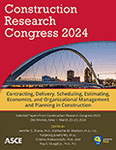Team Collaborations during Times of Disruption: Transaction Costs and Social Network Perspective with Hierarchical Linear Modeling
Publication: Construction Research Congress 2024
ABSTRACT
This study explored changes in communication patterns within construction project teams during times of disruption (i.e., the COVID-19 pandemic), focusing on transaction costs associated with communication and coordination through individual-level project team interactions. Nodes within the communication networks were classified based on their roles (owner, general contractor, designer) and were further categorized into three tiers according to their significance, decision-making authority, and involvement in the project. By utilizing social network analysis (SNA) and hierarchical linear modeling (HLM), the study discerned considerable shifts in network dynamics. Designers and owners in tier 2 showed a decline in network centrality and importance, as evidenced by reduced eigenvector centrality and increased inverse of closeness centrality. Conversely, the owner and general contractor in tier 1 either maintained or slightly enhanced their network importance. Local transitivity, indicating the propensity for nodes to form clusters, fluctuated across roles and tiers. The pandemic typically decreased the authority score, implying diminished perceived credibility of nodes. The elevated communication load on tier 1, mainly including project managers, exerted pressure on their capacity limits. The disruptive period and the potential impacts of COVID-19 marked an irrevocable shift in global communication, not just in the construction industry, necessitating role and tier-specific strategies.
Get full access to this article
View all available purchase options and get full access to this chapter.
REFERENCES
Bajari, P., and Tadelis, S. (2001). “Incentives versus transaction costs: A theory of procurement contracts.” RAND Journal of Economics, 32(3), 387–407.
Bayhan, H. G., Mollaoglu, S., Zhang, H., and Frank, K. A. (2022). “Project Team Collaborations during Time of Disruptions: Transaction Costs, Knowledge Flows, and Social Network Theory Perspective.” In Construction Research Congress 2022 (pp. 1012–1023).
Borgatti, S. P., and Foster, P. C. (2003). “The network paradigm in organizational research: A review and typology.” Journal of Management, 29(6), 991–1013.
Bresnen, M., and Marshall, N. (2000). “Partnering in construction: A critical review of issues, problems, and dilemmas.” Construction Management and Economics, 18(2), 229–237.
Campbell, L., and Kashy, D. A. (2002). “Estimating actor, partner, and interaction effects for dyadic data using PROC MIXED and HLM: A user–friendly guide.” Personal Relationships, 9(3), 327–342.
Covidmapping. (2023). “Michigan COVID-19 Timeline.” CovidMapping. <https://covidmapping.org/timeline.html>(April 21, 2023.).
Eccles, R. G. (1981). “The quasifirm in the construction industry.” Journal of Economic Behavior & Organization, 2(4), 335–357.
Emuze, F., and James, M. (2013). “Exploring communication challenges due to language and cultural diversity on South African construction sites.” Acta Structilia: Journal for the Physical and Development Sciences, 20(1), 44–65.
Fulford, R., and Standing, C. (2014). “Construction industry productivity and the potential for collaborative practice.” International Journal of Project Management, 32(2), 315–326.
Gamil, Y., and Alhagar, A. (2020). “The impact of pandemic crisis on the survival of construction industry: a case of COVID-19.” Mediterranean Journal of Social Sciences, 11(4), 122–122.
Garcia, A. J., Mollaoglu, S., Frank, K. A., Duva, M., and Zhao, D. (2021). “Emergence and evolution of network structures in complex interorganizational project teams.” Journal of Management in Engineering, 37(5), 04021056.
Haaskjold, H., Andersen, B., Lædre, O., and Aarseth, W. (2020). “Factors affecting transaction costs and collaboration in projects.” International Journal of Managing Projects in Business, 13(1), 197–230.
Heide, M., and Simonsson, C. (2021). “What was that all about? On internal crisis communication and communicative coworkership during a pandemic.” Journal of Communication Management, 25(3), 256–275.
Jang, J. W., Woo, J., Mohaisen, A., Yun, J., and Kim, H. K. (2015). “Mal-netminer: Malware classification approach based on social network analysis of system call graph.” Mathematical Problems in Engineering, 2015.
Livingston, B. A., and Judge, T. A. (2008). “Emotional responses to work-family conflict: An examination of gender role orientation among working men and women.” Journal of Applied Psychology, 93(1), 207–216.
Loosemore, M. (1998). “Social network analysis: using a quantitative tool within an interpretative context to explore the management of construction crises.” Engineering, construction and architectural management, 5(4), 315–326.
Majumder, S., and Biswas, D. (2021). “COVID-19 impacts construction industry: now, then and future.” COVID-19: prediction, decision-making, and its impacts, 115–125.
Mele, A. (2022). “A structural model of homophily and clustering in social networks.” Journal of Business & Economic Statistics, 40(3), 1377–1389.
Ozaygen, A., and Balague, C. (2018). “Idea evaluation in innovation contest platforms: A network perspective.” Decision Support Systems, 112, 15–22.
Raudenbush, S. W., and Bryk, A. S. (2002). Hierarchical linear models: Applications and data analysis methods (Vol. 1). sage.
Scott, J. (2017). Social network analysis. Sage Publications.
Williamson, O. E. (1979). “Transaction-cost economics: The governance of contractual relations.” Journal of Law and Economics, 22(2), 233–261.
Information & Authors
Information
Published In
History
Published online: Mar 18, 2024
Authors
Metrics & Citations
Metrics
Citations
Download citation
If you have the appropriate software installed, you can download article citation data to the citation manager of your choice. Simply select your manager software from the list below and click Download.
